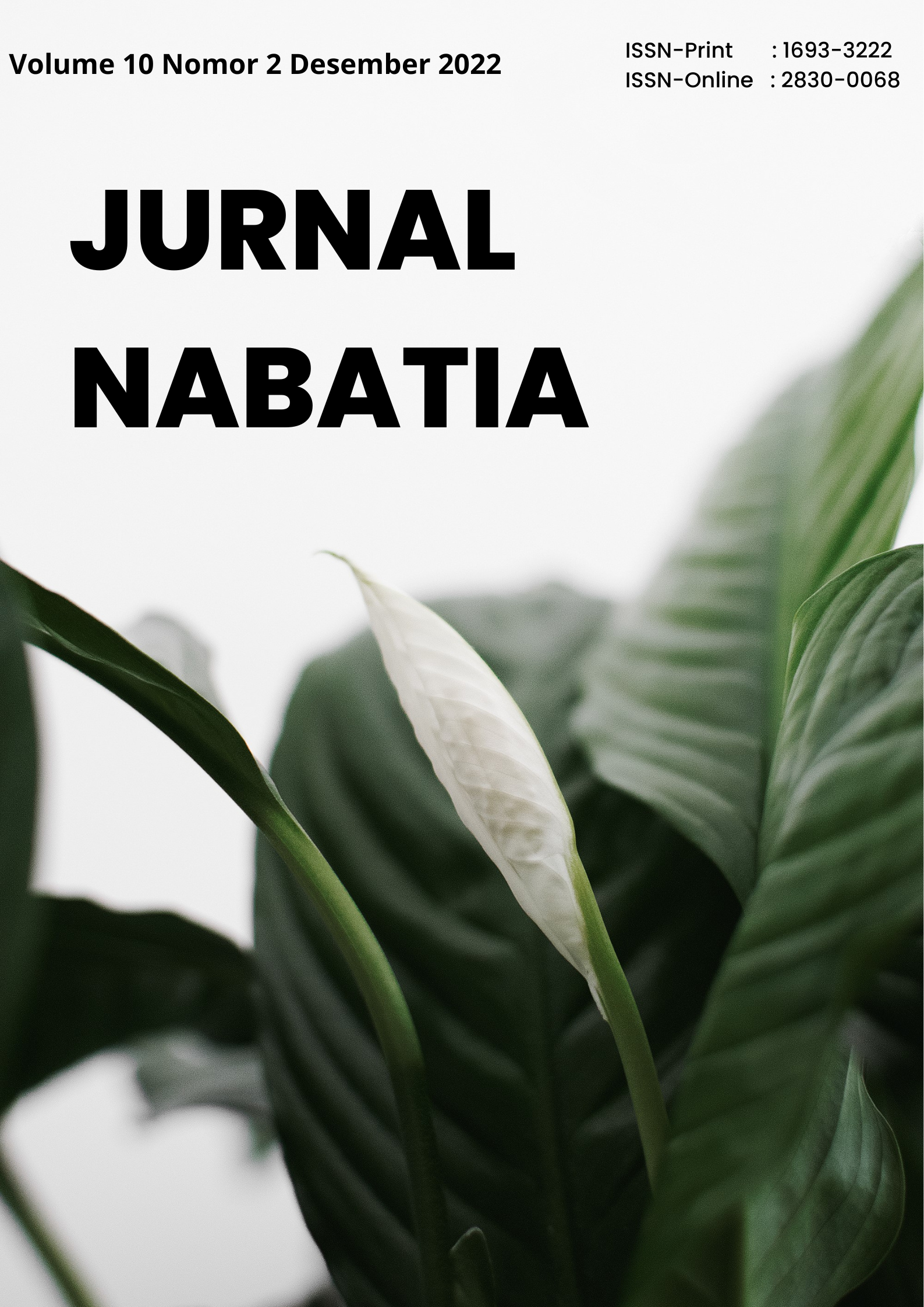Study of Growth and Production of Seven Clones of Sugarcane (Saccharum officinarum L.) Inalluvial Soilin Sambiroto Village, Sooko District-Mojokerto
Kajian Pertumbuhan dan Hasil Tujuh Klon Tanaman Tebu (Saccharum officinarum L.)Pada Tanah Aluvial di Desa Sambiroto Kecamatan Sooko - Mojokerto
DOI:
https://doi.org/10.21070/nabatia.v10i2.1611Keywords:
Growth, Description, Clone, Yield Potential, SugarcaneAbstract
The productivity of sugarcane in Indonesia is still decreasing due to the low value of crystal produced per hectare. One of the main and fundamental factors is the limited availability of superior varieties. The purpose of this study was to determine the differences in growth andyield of clones SB01, SB03 clones, SB04 clones, SB11 clones, SB12 clones, SB19 clones andSB20 clones as well as sugarcane clones that had the best growth. This study used a randomized block design with one factor, namely sugarcane clones SB01, SB3 clones, SB04 clones, SB011 clones, SB12 clones, SB19 clones, SB20 clones. Each replication consisted of 7 sugarcane clones. Which was repeated three times with observation variables which included growth andyield variables. The data were then analyzed using ANOVA variance. If there is a significant difference, continue with the 5% BNT test. There were significant differences between seven sugarcane clones in growth andyield variables in sugarcane. Of the seven clones observed, clone SB12 had good vegetative andgenerative potential with the highestyield of160.67 tons/ha, clone SB01 had the highestyield potential, 11.3% and clone SB01 had the highest crystallizationpotential. namely with a value of 17.6 tons/ha.
References
Kementrian pertanian. 2015. Peraturan Menteri Pertanian No. 53 tahun 2015 tentang Pedoman Budidaya Tebu Giling yang Baik [Regulation of the MInister of Agriculture (MOA) 53/2015 on Good Agricultural Practices/GAP for Sugar Cane]. Hal 7.
Kementrian Pertanian. 2016. Statistik Perkebunan Indonesia - Tebu [Tree Crop Estate Statistics of Indonesia - Sugar Cane] 2015-2017. Direktorat Jenderal Perkebunan, Kementerian Pertanian [Directorate General of Estate Crops, Ministry of Agriculture]. Hal 14
Badan Pusat Statistik. 2016. “Perkembangan Produk Domestik Bruto dan Produk Domestik Bruto per Kapita Atas Dasar Harga Konstan 2010-2016”. Di akses tanggal 27 April 2020.
US Department of Agriculture [USDA]. 2018. Sugar Annual2018. Filipina. Hal 12.
Surdianto, Y., Sunandar, N. dan Rachmat, A. 2014. Adaptasi Beberapa Varietas Tebu di Kabupaten Majalengka Jawa Barat. Balai Pengkajian Teknologi Pertanian Jawa Barat. Bandung.
Budi. Setyo 2014. “Peningkatan Produktivitas Tanaman Tebu Melalui Model Integrasi Kultur Teknik Optimal Berbasis Bibit Single Bud (BudChips) di Provinsi Jawa Timur”. Laporan Penelitian. Penelitian Unggulan Strategi Nasional. Fakultas Pertanian Universitas Muhammadiyah Gresik. Desember 2014. 65 hal.
Apriliani, Dwi Tutut. 2019. Uji Pertumbuhan Tiga Klon Tanaman Tebu (Saccharum Sp.) Pada Level Berbagai Cekaman Garam. Skripsi, Universitas Muhammadiyah Gresik.
Anwar Khoirul. 2020. Identifikasi Karakter MorfologiBeberapa Klon Tanaman Tebu (Saccharum Officinarum L.) Di Desa Sambiroto Kecamatan Sooko - Mojokerto. Praktik Kerja Lapangan. Universitas Muhammadiyah. Gresik
Budi Setyo. 2016. Teknologi Pembuatan Bibit Tebu (Saccharum Officinarum L.) Unggul Bersertifikat. UMM Pres. Malang. Hal 100-101.
Hastono AD, Khuluq AD, Yogi YA. 2016. Tebu sebagai Bahan Baku Produksi Gula Merah dan Gula Cair. Bunga Rampai, Peningkatan Produktivitas Tebu
Kumar, N., H. Singh, R. Kumar, V.P. Singh. 2012. Productivity andprofitability of different genotypes of sugarcane (Saccharum spp) as influenced by fertility levels and planting seasons. Indian J. Agron. 57:180-185.
Mairiyansyah. (2018). Peluang Peningkatan Produksi Gula dan Pendapatan Petani Melalui Program Konsolidasi Pengelolaan Tebu Rakyat (Irham, A. Nurhayati, M. Cholidi, & Daniyanto, Eds.).
Rehman, A., R. Qamar, J. Qamar. 2014. Economis assessment of sugarcane (Saccharum officinarum L.) through intercropping. J. Agric. Chem. Environ. 3:24-28.
Downloads
Published
How to Cite
License
Copyright Notice
Authors retain copyright and grant the journal right of first publication with the work simultaneously licensed under a Creative Commons Attribution 4.0 International License that allows others to share the work with an acknowledgement of the work's authorship and initial publication in this journal.





